
Álamo Oliveira invites you to explore cultural tourism in the Azores
Photo essay organized by Katharine Baker
[Read Álamo's essay and a Washington Post article about visiting the Azores / Consult tables with hyperlinks to Azores travel articles and videos]
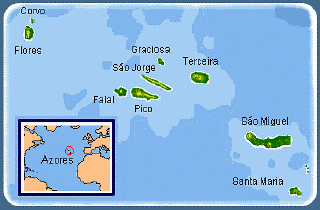
[Click on map to see enlargement]
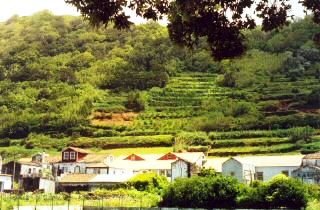
Lajes, Pico: The volcanic island's centuries-long viniculture and winemaking earned it a UNESCO World Heritage site designation in 2004.
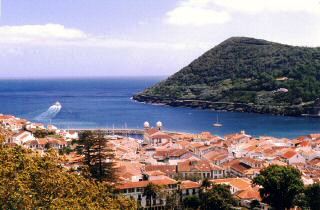
Angra do Heroísmo, Terceira: The city's historic central zone, a UNESCO World Heritage site since 1983, as viewed from the base of the Memória obelisk.
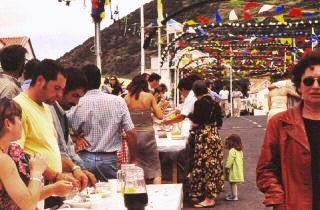
Velas, São Jorge: Authentic mint-scented sopas served over crusty Portuguese bread is provided free to the entire community (and occasional tourist!) by local impérios [fraternal lodges] at luncheons throughout the Azores on feast days. The island chain has many religious and secular festivals during the year.
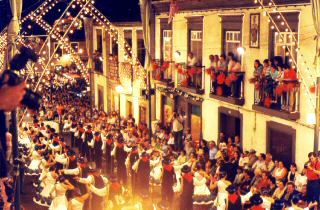
Angra do Heroísmo, Terceira: Sanjoaninas marchas – this weeklong summer solstice celebration includes huge ensembles from island towns singing and dancing their way down the parade route as far as the eye can see, each accompanied by its community's filarmónica [marching band]. In 2012, Sanjoaninas will be held June 20-27.
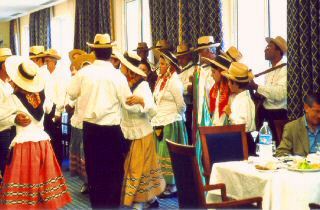
Horta, Faial: Authentically costumed dancers and musicians from the Grupo Folclórico do Salão perform Azorean folk-dances such as the chamarrita, pézinho and sapateia for hotel guests after dinner. At the end of the presentation, the visitors are invited to join in on the dance-floor.
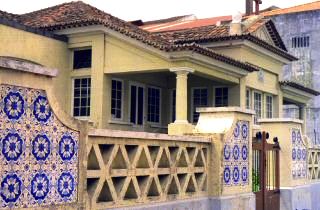
Ponta Delgada, São Miguel: Typical architectural use of traditional blue-and-white azulejo tiles.
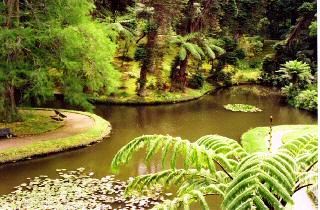
Furnas, São Miguel: A section of the vast Terra Nostra Park gardens, on the historic Hickling family estate.
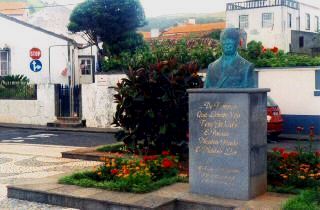
Santa Cruz, Flores: Statue on a public plaza in memory of one of that island's most revered poets, Roberto de Mesquita.
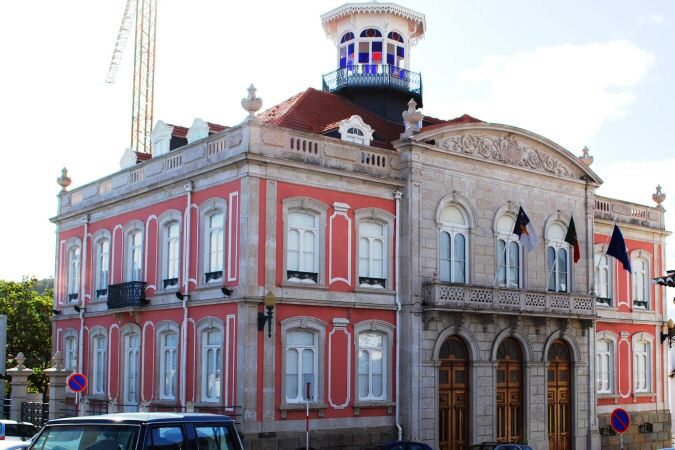
Angra do Heroísmo, Terceira: The Palacete Silveira e Paulo houses the Azores' Directorate of Culture, whose portfolio includes museums, libraries, archives, historic patrimonies, architecture, archaeology – and the fostering of folk, classical and popular Azorean art, music, theater, literature and arts and crafts.
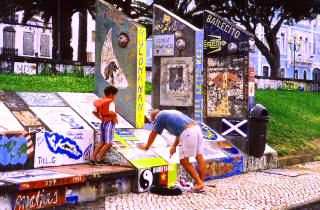
Horta, Faial: Thousands of sailors from 'round the world observe the custom of leaving a painting on a marina wall, in hopes it will bring good luck on their next voyage.
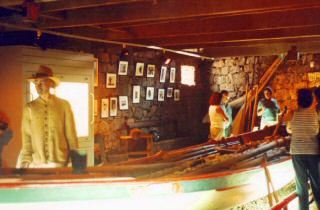
Lajes, Pico: A whale-hunting boat in the Museu dos baleeiros [whalers' museum]. Despite the Azores' long tradition, Portugal ceased whaling over 25 years ago; nowadays, trips via zodiac out of Pico, Faial and São Miguel to watch whales and dolphins in open ocean draw tourists.
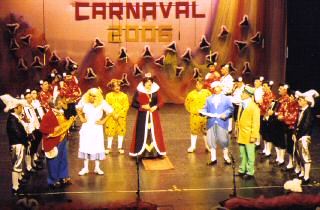
Angra do Heroísmo, Terceira: A tall, hirsute little girl(?) confronts the March Hare during a Carnaval bailinho [short, comic playlet, partially in rhyme] based on the children's classic Alice no país das maravilhas, presented the last four nights before Lent in community auditoriums around the island by an all-male cast from São Pedro da Ribeirinha. Each bailinho and dança de espada is bookended with music and dancing; in this production, "Alice" doubled on castanets.
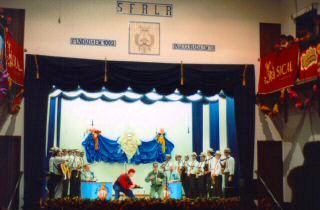
Ribeirinha, Terceira: This original folk-theater bailinho, created and performed by an ensemble from Terra Chã, Terceira, lampooned richly-deserving news anchors, reporters, politicians and athletes. In keeping with the journalistic motif, the group's band was costumed as ink-stained wretches à la the classic film The Front Page – right down to their period pencil-mustaches, and a press credential tucked into the hatband of each fedora. In memoriam, João David Castro Couto.
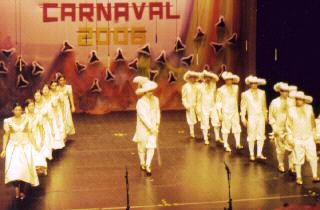
Angra do Heroísmo, Terceira: A traditional Carnaval dança de espada [sword dance] presented by a troupe from Feteira; unlike a bailinho, the dança's playlet is by custom melodramatic. Numerous bailinho and dança groups (including from Portuguese community organizations in the US and Canada) ply the island for four consecutive nights, playing a succession of local stages (here, at the sumptuous Teatro Angrense) from early evening till the wee small hours.
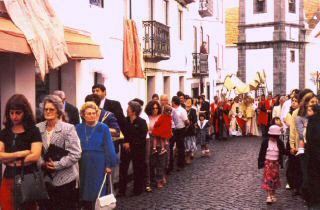
Velas, São Jorge: Solemn procession with Padre Manuel Garcia da Silveira (c., rear) and parishioners wends its way through the center of town after a feast day Mass in Velas' Igreja Matriz [Mother Church].
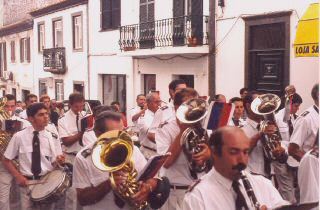
Velas, São Jorge: Everybody loves a marching band! A filarmónica comprising men and women of all ages parades through town; the tradition also continues in Portuguese-descendant communities of North America.
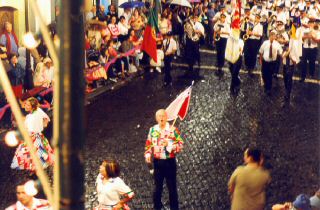
Angra do Heroísmo, Terceira: Álamo Oliveira takes a break between performances with the Comunidades contingent to salute friends viewing the Sanjoaninas marchas from a balcony party along Rua da Sé.
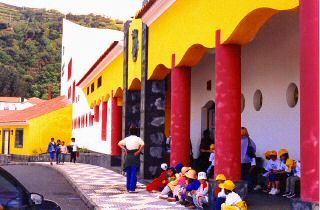
Velas, São Jorge: Students and teachers wait outside the Municipal Auditorium for the International Day of the Child celebrations to start.
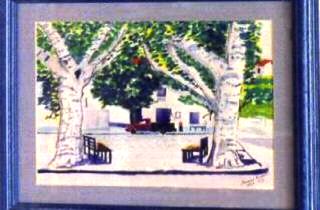
Santa Cruz, Flores: A plaza, captured in watercolors by Armin Klatt, formerly of Lajes, Terceira. The Azores' abundance of stunning scenery (both man-made and natural) constitutes a veritable artists' paradise.
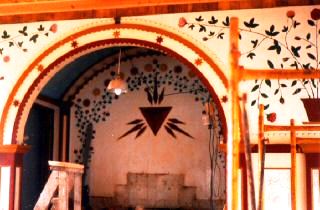
Fajãzinha, Flores: Under renovation, the interior of an I.D.E.S. império [Irmandade do Divino Espírito Santo empire, or lodge] in Europe's westernmost jurisdiction.
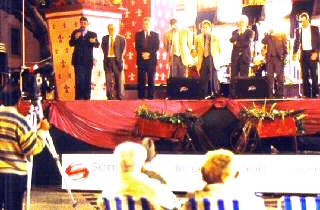
Angra do Heroísmo, Terceira: A stageful of singers challenges one another to improvise the best song verses at a traditional cantoria ao desafio [singing challenge] on the Praça Velha, Angra's central plaza, late one night during Sanjoaninas.
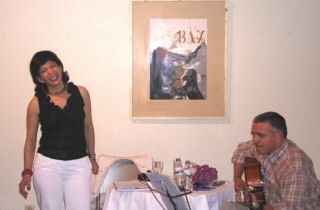
Feteira, Terceira: Local vocalist Deka Purim (a native of southern Brazil) and guitarist Duarte Dores (who lived for many years in Rio de Janeiro – Ele é carioca!) present an evening of bossa nova music at doctor/artist Dimas Lopes' Carmina Gallery for Contemporary Art.
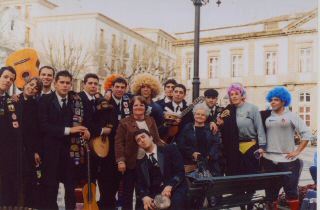
Angra do Heroísmo, Terceira: Posing with two new friends on the Praça Velha, an irrepressible university musical ensemble visiting from Porto for the tunas [singing festival] publicizes their upcoming concert at the Teatro Angrense.
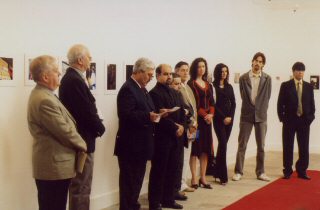
Angra do Heroísmo, Terceira: Eight photographers from around the world chose their best shots of Carnaval to display later in the week; Álamo Oliveira (2nd from l.) was among dignitaries at the opening.
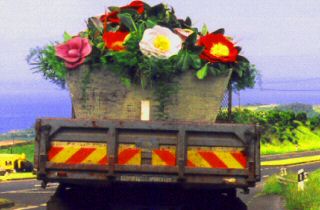
En route from Praia da Vitória, Terceira: Giant basket of artificial flowers being trucked down the Vitorino Nemésio Via Rápida to Angra do Heroísmo, to decorate the Praça Velha during Sanjoaninas.
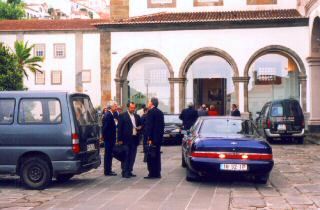
Angra do Heroísmo, Terceira: The Museum of Angra do Heroísmo is housed in the former São Francisco Convent. Most islands have at least one museum.
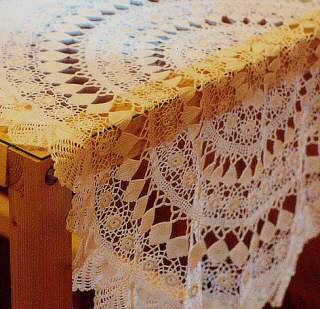
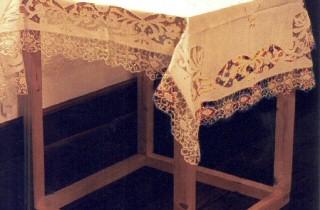
Angra do Heroísmo, Terceira: Exquisite samples of antique handmade rendas [needlework] from various islands in the Azores were part of a visiting exhibit at the historical landmark Palácio dos Capitães Generais.

Horta, Faial: Fernando M. Faria Ribeiro (l.), doing research at the Public Library. Pre-1911 Azores vital records and historical materials are stored in archives at public libraries, by region: west (Corvo, Faial, Flores, Pico) in Horta; central (Graciosa, São Jorge, Terceira) in Angra do Heroísmo; east (Santa Maria, São Miguel) in Ponta Delgada. The Directorate of Culture offers additional genealogical resources at its headquarters and online; other historical records are online in Lisbon.
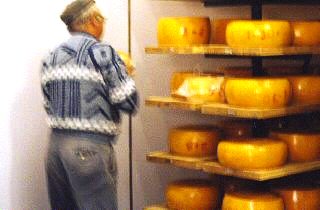
Topo, São Jorge: Cheese – milk's leap to immortality! The witty aphorism was never more apt than at this factory where São Jorge cheese (a denomination of protected origin) is manufactured, then aged to piquant perfection for domestic and international consumption.
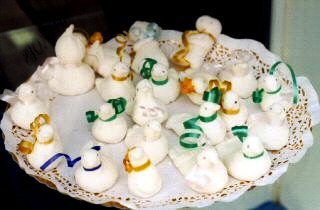
Angra do Heroísmo, Terceira: Traditional Portuguese alfenim (sugar candy believed to have originated with the Moors), molded into a flock of beribboned Easter chicks perching in the window of a confectioner's shop downtown during Lent.
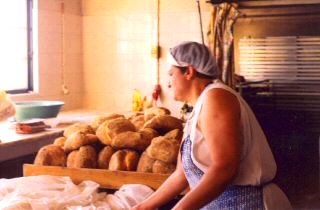
Calheta, São Jorge: Ahhh... there's nothing like the fragrance of freshly-baked artisanal breads, the norm throughout the Azores – including (above) handcrafted crusty pão de milho loaves made with fine cornmeal and baked in wood-burning ovens, papo secos (hard rolls), massa sovada (soft, sweet egg bread) and bolo lêvedo (yeast muffins).
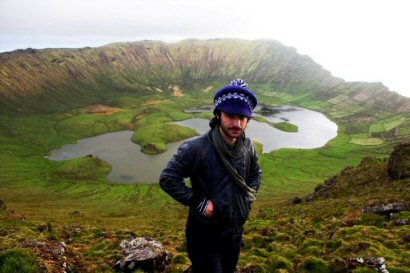
Corvo: It’s Earth Not the Moon, by Portuguese director Gonçalo Tocha, won the 2012 Golden Gate Award for Best Documentary Feature at the 55th San Francisco International Film Festival. "The 185 minute award-winning 2011 documentary was filmed on Corvo, the smallest of the nine islands of the Azores. Gonçalo received a $20,000 cash prize. The film was released in 2012. The documentary has won several international film awards: Special Mention at the 2011 Locarno Film Festival; Best Feature Film Award, 2011 DOCLisboa International Film Competition." Portuguese-American Journal, 3 May 2012. Photo by Rui Soares
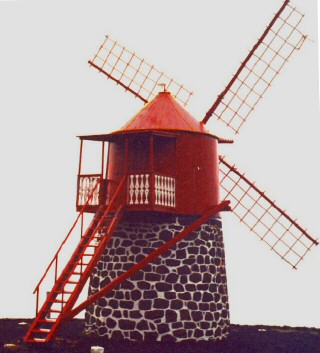
One of many restored historic structures recognized by the Azorean Institute of Culture as a regional patrimony.
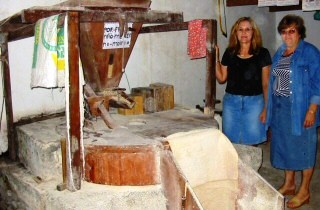
São Miguel (above): Lucy Fontes (l.) and her cousin admire an old grain mill powered by a nearby stream.
Near Madalena, Pico (left): After 15th-century Portuguese mariners discovered the Azores, settlers began arriving from the mainland. The crown also invited Flemish farmers, who harnessed the power of ocean breezes with Dutch-style windmills they built on bases of local basalt. A half-millennium later, high-tech wind turbine farms are being tested as part of the Azores' goal of attaining energy self-sufficiency via renewable sources.
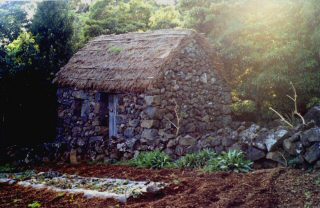
São Mateus, Terceira: Located on the outskirts of Angra do Heroísmo, Gilberto Vieira's Quinta do Martelo ("Hammer Farm," named after the main gate's iconic antique door-knocker) recreates 18th-century rural life in the Azores via authentic buildings, horticulture and preservation of period agricultural trades and crafts. Today the quinta offers modern resort accomodations in a rustic setting, a food shop and a restaurant featuring organically-raised traditional local cuisine.
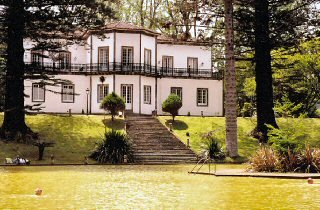
Furnas, São Miguel: Boston businessman Thomas Hickling built Yankee Hall (now called Casa do Parque) in 1770 as his summer retreat from Ponta Delgada. In 1795 President George Washington appointed Hickling the first US vice consul in the Azores. In front of his villa, hot springs feed a large natural outdoor swimming pool on the grounds of the Terra Nostra Garden Hotel, to which generations of tourists have flocked in order to "take the waters."
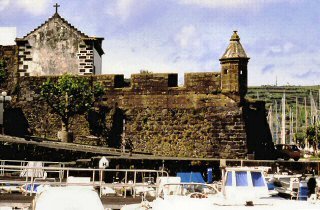
Horta, Faial: The 16th-century Estalagem Santa Cruz stands guard over Faial and the channel between Horta and Madalena, Pico. During the War of 1812 sailors from three British man-of-wars, in violation of Portugal's neutrality laws, seized the captain and crew of the privateer USS General Armstrong as she lay in Horta harbor to re-supply. Designated a national monument in 1947, the fortress is fully modernized inside, and now operates as a tourist pousada.
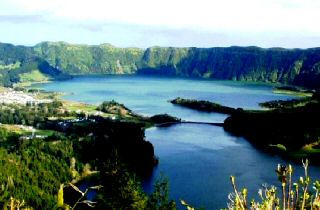
Sete Cidades, São Miguel: Legend tells of the king of Seven Cities, whose daughter fell in love with a poor shepherd. Her father forbade the romance, causing the lovers, upon their forced parting, to weep so copiously that their tears formed twin lakes joined for eternity – one lake green for his eye color, the other blue for hers.
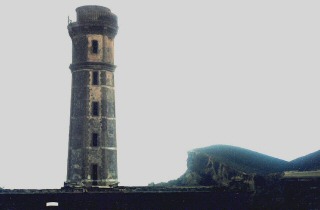
Capelinhos, Faial: 2007 marked the golden anniversary of the start of a year of volcanic eruptions off the island's west coast. With advance warning, all residents were able to flee, although destruction was extensive. Eventually a square mile of new land spread past the lighthouse, whose first story is still buried in black ash.
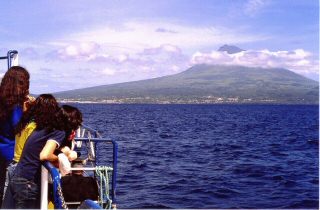
Crossing historic Fayal Roads to Pico: The Cruzeiro das Ilhas is one in a fleet of passenger ferries plying the central island group's waters: the Horta-Madalena shuttle runs daily year-round. The auto ferries Golfinho Azul and Lady of Mann operate from May to September throughout the entire archipelago.
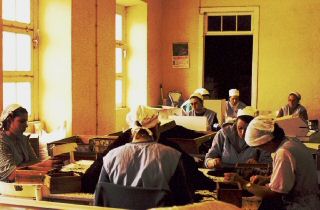
Maia, São Miguel: Women at Gorreana Tea factory – Western Europe's only tea plantation – serenade tourists with folksongs while sorting cured leaves by size and grade for loose-leaf tea and teabags.
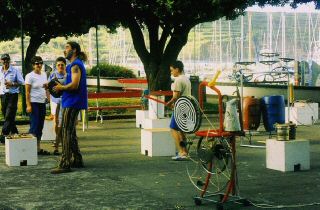
Horta, Faial: Street entertainers captivate children of all ages with music, humor and magic tricks on a sunny Sunday afternoon under spreading shade-trees in the Largo do Infante (Prince Henry the Navigator plaza).
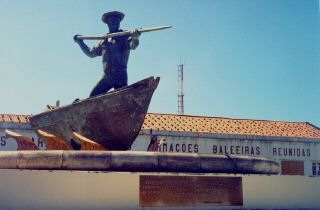
São Roque, Pico: Bronze statue of a harpooner in his whaling boat stands sentry at the Museu da Indústria Baleeira, housed in a defunct whale-processing factory on the north coast across the channel from São Jorge.
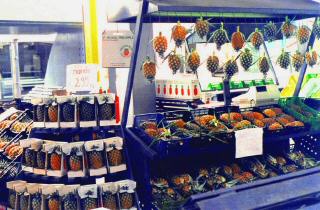
Ponta Delgada, São Miguel: Sweet ripe pineapples of all sizes – raised in the island's 6,000+ hothouses – for sale in Azorean mercados, along with other year-round local produce. Restaurants serve Micaelense pineapple fresh and in desserts; it's also distilled into liqueur.
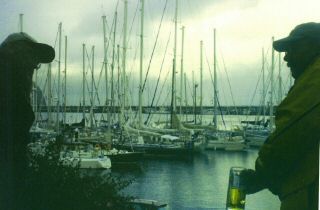
Horta, Faial: Jeff Keller (l.) and fellow crew member relax outside the landmark sailors' watering hole Peter Café Sport during a scheduled maintenance/resupply stop midway through a transatlantic repositioning cruise of the Swan 66 yacht Xanthippe (3rd from l., blue hull).
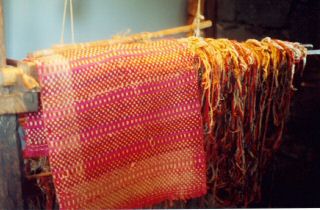
Lajes, Pico: An antique loom on display in the Museu dos baleeiros [whalers' museum], along with traditional hand-woven fabric typical of textiles made from homespun yarns by Azorean women.